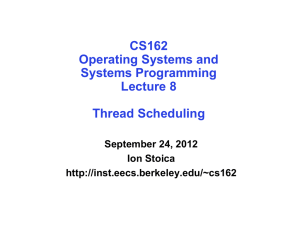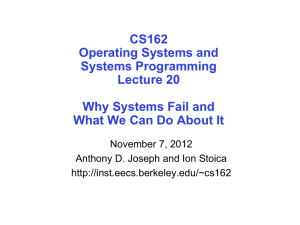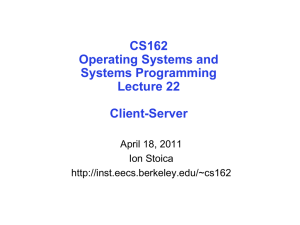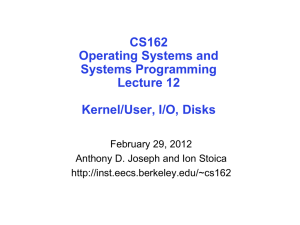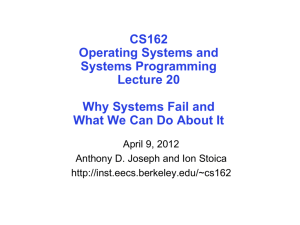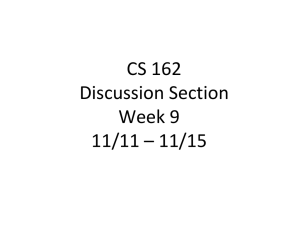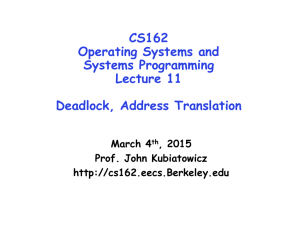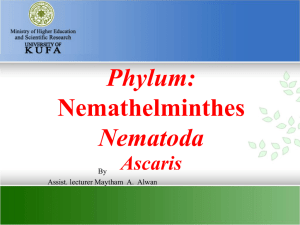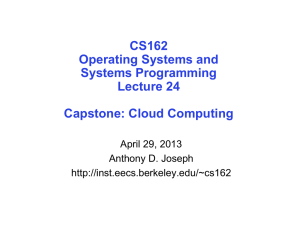Lecture 1 - EECS Instructional Support Group Home Page
advertisement
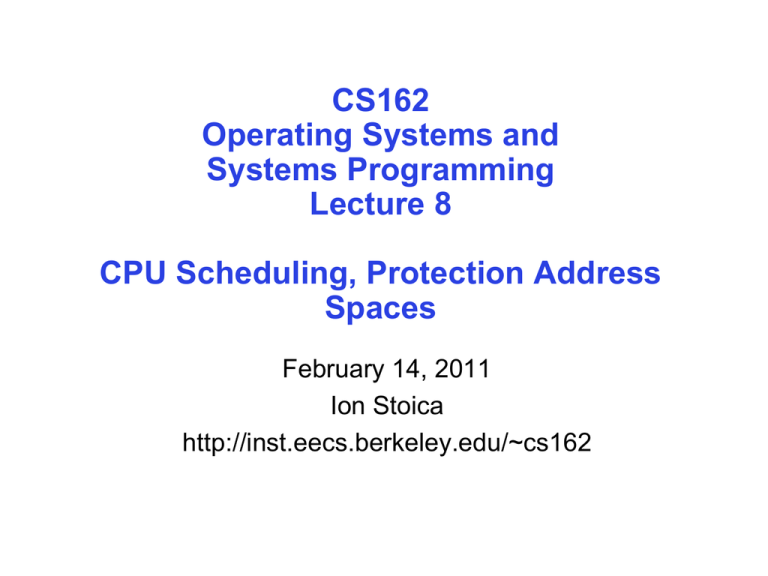
CS162 Operating Systems and Systems Programming Lecture 8 CPU Scheduling, Protection Address Spaces February 14, 2011 Ion Stoica http://inst.eecs.berkeley.edu/~cs162 Review: Last Time • Scheduling: selecting a waiting process from the ready queue and allocating the CPU to it • FCFS Scheduling: – Run threads to completion in order of submission – Pros: Simple (+) – Cons: Short jobs get stuck behind long ones (-) • Round-Robin Scheduling: – Give each thread a small amount of CPU time when it executes; cycle between all ready threads – Pros: Better for short jobs (+) – Cons: Poor when jobs are same length (-) 2/14 Ion Stoica CS162 ©UCB Spring 2011 Lec 8.2 Goals for Today • • • • Finish discussion of Scheduling Kernel vs User Mode What is an Address Space? How is it Implemented? Note: Some slides and/or pictures in the following are adapted from slides ©2005 Silberschatz, Galvin, and Gagne 2/14 Ion Stoica CS162 ©UCB Spring 2011 Lec 8.3 Round-Robin Discussion • How do you choose time slice? – What if too big? » Response time suffers – What if infinite ()? » Get back FIFO – What if time slice too small? » Throughput suffers! • Actual choices of timeslice: – Initially, UNIX timeslice one second: » Worked ok when UNIX was used by one or two people. » What if three compilations going on? 3 seconds to echo each keystroke! – In practice, need to balance short-job performance and longjob throughput: » Typical time slice today is between 10ms – 100ms » Typical context-switching overhead is 0.1ms – 1ms » Roughly 1% overhead due to context-switching 2/14 Ion Stoica CS162 ©UCB Spring 2011 Lec 8.4 Comparisons between FCFS and Round Robin • Assuming zero-cost context-switching time, is RR always better than FCFS? • Simple example: 10 jobs, each takes 100s of CPU time • Completion Times: RR scheduler quantum of 1s All jobs start at the same time Job # FIFO RR 1 100 991 2 200 992 … … … 9 900 999 10 1000 1000 – Both RR and FCFS finish at the same time – Average response time is much worse under RR! » Bad when all jobs same length • Also: Cache state must be shared between all jobs with RR but can be devoted to each job with FCFS – Total time for RR longer even for zero-cost switch! 2/14 Ion Stoica CS162 ©UCB Spring 2011 Lec 8.5 Earlier Example with Different Time Quantum P2 P4 Best FCFS: [8] [24] 0 8 P1 [53] 32 P3 [68] 85 153 Quantum P1 P2 P3 P4 Average Best FCFS 32 0 85 8 31¼ P1 P2 P3 P4 P1 P3 P4 P1 P3 P4 P1 P3 P1 P3 P1 P3 P1 P3 P3 P3 Q=1 84 22 85 57 62 133 141 149 153 0 8 16 24 32 80 88 96 Q =40 5 48 56 8264 72 20 85 104 11258120 128 61¼ Wait Q=8 80 8 85 56 57¼ Time Q = 10 82 10 85 68 61¼ Q = 20 72 20 85 88 66¼ Worst FCFS 68 145 0 121 83½ Best FCFS 85 8 153 32 69½ Q=1 137 30 153 81 100½ Q=5 135 28 153 82 99½ Completion Q=8 133 16 153 80 95½ Time Q = 10 135 18 153 92 99½ Q = 20 125 28 153 112 104½ Worst FCFS 121 153 68 145 121¾ 2/14 Ion Stoica CS162 ©UCB Spring 2011 Lec 8.6 What if we Knew the Future? • Could we always mirror best FCFS? • Shortest Job First (SJF): – Run whatever job has the least amount of computation to do • Shortest Remaining Time First (SRTF): – Preemptive version of SJF: if job arrives and has a shorter time to completion than the remaining time on the current job, immediately preempt CPU • These can be applied either to a whole program or the current CPU burst of each program – Idea is to get short jobs out of the system – Big effect on short jobs, only small effect on long ones – Result is better average response time 2/14 Ion Stoica CS162 ©UCB Spring 2011 Lec 8.7 Discussion • SJF/SRTF are the best you can do at minimizing average response time – Provably optimal (SJF among non-preemptive, SRTF among preemptive) – Since SRTF is always at least as good as SJF, focus on SRTF • Comparison of SRTF with FCFS and RR – What if all jobs the same length? » SRTF becomes the same as FCFS (i.e. FCFS is best can do if all jobs the same length) – What if jobs have varying length? » SRTF (and RR): short jobs not stuck behind long ones 2/14 Ion Stoica CS162 ©UCB Spring 2011 Lec 8.8 Example to illustrate benefits of SRTF C A or B C’s I/O • Three jobs: C’s I/O C’s I/O – A,B: CPU bound, each run for a week C: I/O bound, loop 1ms CPU, 9ms disk I/O – If only one at a time, C uses 90% of the disk, A or B could use 100% of the CPU • With FIFO: – Once A or B get in, keep CPU for one week each • What about RR or SRTF? – Easier to see with a timeline 2/14 Ion Stoica CS162 ©UCB Spring 2011 Lec 8.9 RR vs. SRTF C A B RR 100ms time slice C’s I/O CABAB… C Disk Utilization: 9/201 C ~ 4.5% DiskC’s Utilization: ~90% I/Obut lots of wakeups! RR 1ms time slice C’s I/O C A C’s I/O 2/14 C’s I/O A C’s I/O Disk Utilization: 90% A SRTF Ion Stoica CS162 ©UCB Spring 2011 Lec 8.10 • Starvation SRTF Further discussion – SRTF can lead to starvation if many small jobs! – Large jobs never get to run • Somehow need to predict future – How can we do this? – Some systems ask the user » When you submit a job, have to say how long it will take » To stop cheating, system kills job if takes too long – But: even non-malicious users have trouble predicting runtime of their jobs • Bottom line, can’t really know how long job will take – However, can use SRTF as a yardstick for measuring other policies – Optimal, so can’t do any better • SRTF Pros & Cons 2/14 – Optimal (average response time) (+) – Hard to predict future (-) – Unfair (-) Ion Stoica CS162 ©UCB Spring 2011 Lec 8.11 Multi-Level Feedback Scheduling Long-Running Compute Tasks Demoted to Low Priority • Multiple queues, each with different priority – Higher priority queues often considered “foreground” tasks • Each queue has its own scheduling algorithm – e.g. foreground – RR, background – FCFS • Adjust each job’s priority as follows (details vary) – Job starts in highest priority queue – If it doesn’t finish in its time quantum, drop one level – If it finishes, push up one level (or to top) 2/14 Ion Stoica CS162 ©UCB Spring 2011 Lec 8.12 Scheduling Fairness • What about fairness? – Strict fixed-priority scheduling between queues is unfair (run highest, then next, etc): » long running jobs may never get CPU » In Multics, shut down machine, found 10-year-old job – Must give long-running jobs a fraction of the CPU even when there are shorter jobs to run – Tradeoff: fairness gained by hurting avg response time! • How to implement fairness? – Could give each queue some fraction of the CPU » What if one long-running job and 100 short-running ones? » Like express lanes in a supermarket—sometimes express lanes get so long, get better service by going into one of the other lines – Could increase priority of jobs that don’t get service » What is done in UNIX » This is ad hoc—what rate should you increase priorities? 2/14 Ion Stoica CS162 ©UCB Spring 2011 Lec 8.13 Lottery Scheduling • Yet another alternative: Lottery Scheduling – Give each job some number of lottery tickets – On each time slice, randomly pick a winning ticket – On average, CPU time is proportional to number of tickets given to each job • How to assign tickets? – To approximate SRTF, short running jobs get more, long running jobs get fewer – To avoid starvation, every job gets at least one ticket (everyone makes progress) • Advantage over strict priority scheduling: behaves gracefully as load changes – Adding or deleting a job affects all jobs proportionally, independent of how many tickets each job possesses 2/14 Ion Stoica CS162 ©UCB Spring 2011 Lec 8.14 Lottery Scheduling Example • Lottery Scheduling Example – Assume short jobs get 10 tickets, long jobs get 1 ticket # short jobs/ # long jobs 1/1 0/2 2/0 10/1 1/10 % of CPU each short jobs gets % of CPU each long jobs gets 91% N/A 50% 9.9% 50% 9% 50% N/A 0.99% 5% – What if too many short jobs to give reasonable response time? » In UNIX, if load average is 100, hard to make progress » One approach: log some user out 2/14 Ion Stoica CS162 ©UCB Spring 2011 Lec 8.15 A Final Word On Scheduling • When do the details of the scheduling policy and fairness really matter? – When there aren’t enough resources to go around • When should you simply buy a faster computer? • An interesting implication of this curve: 100% » Might think that you should buy a faster X when X is utilized 100%, but usually, response time goes to infinity as utilization100% Response time – (Or network link, or expanded highway, or …) – One approach: Buy it when it will pay for itself in improved response time Utilization – Most scheduling algorithms work fine in the “linear” portion of the load curve, fail otherwise – Argues for buying a faster X when hit “knee” of curve 2/14 Ion Stoica CS162 ©UCB Spring 2011 Lec 8.16 Administrivia • Deadlines, project 1: – Design: Tomorrow, February 15th – Code: March 1st – Submitting instructions posted on Piazzza 2/14 Ion Stoica CS162 ©UCB Spring 2011 Lec 8.17 5min Break 2/14 Ion Stoica CS162 ©UCB Spring 2011 Lec 8.18 Virtualizing Resources • Physical Reality: Different Processes/Threads share the same hardware – Need to multiplex CPU (Just finished: scheduling) – Need to multiplex use of Memory (Today) – Need to multiplex disk and devices (later in term) • Why worry about memory sharing? – The complete working state of a process and/or kernel is defined by its data in memory (and registers) – Consequently, cannot just let different threads of control use the same memory – Probably don’t want different threads to even have access to each other’s memory (protection) 2/14 Ion Stoica CS162 ©UCB Spring 2011 Lec 8.19 Recall: Single and Multithreaded Processes • Threads encapsulate execution (concurrency) – “Active” component of a process • Address spaces encapsulate protection – Keeps buggy program from trashing the system – “Passive” component of a process 2/14 Ion Stoica CS162 ©UCB Spring 2011 Lec 8.20 Important Aspects of Memory Multiplexing • Controlled overlap: – Processes should not collide in physical memory – Conversely, would like the ability to share memory when desired (for communication) • Protection: – Prevent access to private memory of other processes » Different pages of memory can be given special behavior (Read Only, Invisible to user programs, etc). » Kernel data protected from User programs » Programs protected from themselves • Translation: – Ability to translate accesses from one address space (virtual) to a different one (physical) – When translation exists, processor uses virtual addresses, physical memory uses physical addresses – Side effects: » Can be used to avoid overlap » Can be used to give uniform view of memory to programs 2/14 Ion Stoica CS162 ©UCB Spring 2011 Lec 8.21 Binding of Instructions and Data to Memory • Assume 4byte words Binding of instructions and data to addresses: 0x300 = 4 * 0x0C0 – Choose addresses for instructions and data the 1100 0000 0x0C0from = 0000 standpoint of the processor 0x300 = 0011 0000 0000 data1: dw 32 … start: lw r1,0(data1) jal checkit loop: addi r1, r1, -1 bnz r1, r0, loop … checkit: … 0x300 … 0x900 0x904 0x908 0x90C … 0xD00 00000020 … 8C2000C0 0C000340 2021FFFF 1420FFFF … – Could we place data1, start, and/or checkit at different addresses? » Yes » When? Compile time/Load time/Execution time – Related: which physical memory locations hold particular instructions or data? 2/14 Ion Stoica CS162 ©UCB Spring 2011 Lec 8.22 Multi-step Processing of a Program for Execution • Preparation of a program for execution involves components at: – Compile time (i.e., “gcc”) – Link/Load time (unix “ld” does link) – Execution time (e.g. dynamic libs) • Addresses can be bound to final values anywhere in this path – Depends on hardware support – Also depends on operating system • Dynamic Libraries – Linking postponed until execution – Small piece of code, stub, used to locate appropriate memory-resident library routine – Stub replaces itself with the address of the routine, and executes routine 2/14 Ion Stoica CS162 ©UCB Spring 2011 Lec 8.23 Uniprogramming • Uniprogramming (no Translation or Protection) – Application always runs at same place in physical memory since only one application at a time – Application can access any physical address Operating System Valid 32-bit Addresses 0xFFFFFFFF Application 0x00000000 – Application given illusion of dedicated machine by giving it reality of a dedicated machine • Of course, this doesn’t help us with multithreading 2/14 Ion Stoica CS162 ©UCB Spring 2011 Lec 8.24 Multiprogramming (First Version) • Multiprogramming without Translation or Protection – Must somehow prevent address overlap between threads 0xFFFFFFFF Operating System Application2 0x00020000 Application1 0x00000000 – Trick: Use Loader/Linker: Adjust addresses while program loaded into memory (loads, stores, jumps) » Everything adjusted to memory location of program » Translation done by a linker-loader » Was pretty common in early days • With this solution, no protection: bugs in any program can cause other programs to crash or even the OS 2/14 Ion Stoica CS162 ©UCB Spring 2011 Lec 8.25 Multiprogramming (Version with Protection) • Can we protect programs from each other without translation? 0xFFFFFFFF Operating System Application2 LimitAddr=0x10000 0x00020000 BaseAddr=0x20000 Application1 0x00000000 – Yes: use two special registers BaseAddr and LimitAddr to prevent user from straying outside designated area » If user tries to access an illegal address, cause an error – During switch, kernel loads new base/limit from TCB » User not allowed to change base/limit registers 2/14 Ion Stoica CS162 ©UCB Spring 2011 Lec 8.26 Segmentation with Base and Limit Registers Base Virtual Address + CPU Limit <? DRAM Physical Address No: Error! • Could use base/limit for dynamic address translation (often called “segmentation”): – Alter address of every load/store by adding “base” – User allowed to read/write within segment » Accesses are relative to segment so don’t have to be relocated when program moved to different segment – User may have multiple segments available (e.g x86) 2/14 » Loads and stores include segment ID in opcode: x86 Example: mov [es:bx],ax. » Operating system moves around segment base pointers as necessary Ion Stoica CS162 ©UCB Spring 2011 Lec 8.27 Issues with simple segmentation method process 6 process 6 process 6 process 6 process 5 process 5 process 5 process 5 process 9 process 9 process 2 OS process 10 OS OS OS • Fragmentation problem – Not every process is the same size – Over time, memory space becomes fragmented • Hard to do inter-process sharing – Want to share code segments when possible – Want to share memory between processes – Helped by by providing multiple segments per process • Need enough physical memory for every process 2/14 Ion Stoica CS162 ©UCB Spring 2011 Lec 8.28 Multiprogramming (Translation and Protection v2) • Problem: Run multiple applications in such a way that they are protected from one another • Goals: – Isolate processes and kernel from one another – Allow flexible translation that: » Doesn’t lead to fragmentation » Allows easy sharing between processes » Allows only part of process to be resident in physical memory • (Some of the required) Hardware Mechanisms: – General Address Translation » Flexible: Can fit physical chunks of memory into arbitrary places in users address space » Not limited to small number of segments » Think of this as providing a large number (thousands) of fixedsized segments (called “pages”) – Dual Mode Operation » Protection base involving kernel/user distinction 2/14 Ion Stoica CS162 ©UCB Spring 2011 Lec 8.29 Example of General Address Translation Data 2 Code Data Heap Stack Code Data Heap Stack Stack 1 Heap 1 Code 1 Stack 2 Prog 1 Virtual Address Space 1 Prog 2 Virtual Address Space 2 Data 1 Heap 2 Code 2 OS code Translation Map 1 OS data Translation Map 2 OS heap & Stacks 2/14 Physical Address Space Ion Stoica CS162 ©UCB Spring 2011 Lec 8.30 Two Views of Memory CPU Virtual Addresses MMU Physical Addresses Untranslated read or write • Recall: Address Space: – All the addresses and state a process can touch – Each process and kernel has different address space • Consequently, two views of memory: – View from the CPU (what program sees, virtual memory) – View from memory (physical memory) – Translation box converts between the two views • Translation helps to implement protection – If task A cannot even gain access to task B’s data, no way for A to adversely affect B • With translation, every program can be linked/loaded into same region of user address space 2/14 Ion Stoica CS162 ©UCB Spring 2011 Lec 8.31 Example of Translation Table Format Two-level Page Tables 32-bit address: 10 P1 index 10 P2 index 1K PTEs 4KB 12 page offset 4 bytes • Page: a unit of memory translatable by memory management unit (MMU) – Typically 1K – 8K • Page table structure in memory – Each user has different page table • Address Space switch: change pointer to base of table (hardware register) 4 bytes – Hardware traverses page table (for many architectures) – MIPS uses software to traverse table 2/14 Ion Stoica CS162 ©UCB Spring 2011 Lec 8.32 Dual-Mode Operation • Can Application Modify its own translation tables? – If it could, could get access to all of physical memory – Has to be restricted somehow • To Assist with Protection, hardware provides at least two modes (Dual-Mode Operation): – “Kernel” mode (or “supervisor” or “protected”) – “User” mode (Normal program mode) – Mode set with bits in special control register only accessible in kernel-mode • Intel processor actually has four “rings” of protection: – PL (Priviledge Level) from 0 – 3 » PL0 has full access, PL3 has least – Typical OS kernels on Intel processors only use PL0 (“user”) and PL3 (“kernel”) 2/14 Ion Stoica CS162 ©UCB Spring 2011 Lec 8.33 For Protection, Lock User-Programs in Asylum • Idea: Lock user programs in padded cell with no exit or sharp objects – Cannot change mode to kernel mode – User cannot modify page table mapping – Limited access to memory: cannot adversely effect other processes » Side-effect: Limited access to memory-mapped I/O operations – What else needs to be protected? • A couple of issues – How to share CPU between kernel and user programs? » Kinda like both the inmates and the warden in asylum are the same person. How do you manage this??? – How does one switch between kernel and user modes? » OS user (kernel user mode): getting into cell » User OS (user kernel mode): getting out of cell 2/14 Ion Stoica CS162 ©UCB Spring 2011 Lec 8.34 How to get from KernelUser • What does the kernel do to create a new user process? – Allocate and initialize process control block – Read program off disk and store in memory – Allocate and initialize translation table » Point at code in memory so program can execute » Possibly point at statically initialized data – Run Program: » » » » Set machine registers Set hardware pointer to translation table Set processor status word for user mode Jump to start of program • How does kernel switch between processes? – Same saving/restoring of registers as before – Save/restore hardware pointer to translation table 2/14 Ion Stoica CS162 ©UCB Spring 2011 Lec 8.35 UserKernel (System Call) • Can’t let inmate (user) get out of padded cell on own – Would defeat purpose of protection! – So, how does the user program get back into kernel? • System call: Voluntary procedure call into kernel – Hardware for controlled UserKernel transition – Can any kernel routine be called? » No! Only specific ones. – System call ID encoded into system call instruction » Index forces well-defined interface with kernel 2/14 Ion Stoica CS162 ©UCB Spring 2011 Lec 8.36 Summary (1) • Shortest Job First (SJF)/Shortest Remaining Time First (SRTF): – Run whatever job has the least amount of computation to do/least remaining amount of computation to do – Pros: Optimal (average response time) – Cons: Hard to predict future, Unfair • Multi-Level Feedback Scheduling: – Multiple queues of different priorities – Automatic promotion/demotion of process priority in order to approximate SJF/SRTF • Lottery Scheduling: – Give each thread a priority-dependent number of tokens (short tasksmore tokens) – Reserve a minimum number of tokens for every thread to ensure forward progress/fairness • Evaluation of mechanisms: – Analytical, Queuing Theory, Simulation 2/14 Ion Stoica CS162 ©UCB Spring 2011 Lec 8.37 Summary (2) • Memory is a resource that must be shared – Controlled Overlap: only shared when appropriate – Translation: Change virtual addresses into physical addresses – Protection: Prevent unauthorized sharing of resources • Simple Protection through segmentation – Base+limit registers restrict memory accessible to user – Can be used to translate as well • Full translation of addresses through Memory Management Unit (MMU) – Every Access translated through page table – Changing of page tables only available to user • Dual-Mode – Kernel/User distinction: User restricted – UserKernel: System calls, Traps, or Interrupts 2/14 Ion Stoica CS162 ©UCB Spring 2011 Lec 8.38
